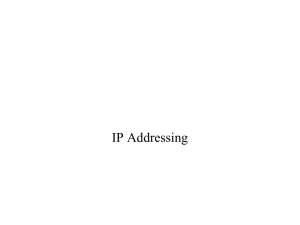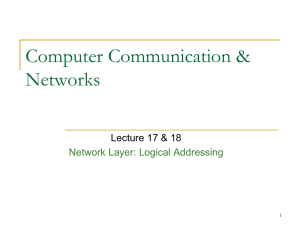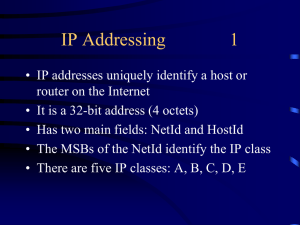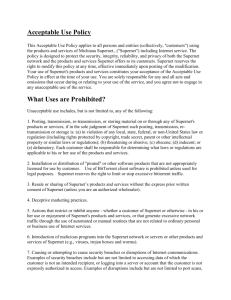The Network Layer
advertisement
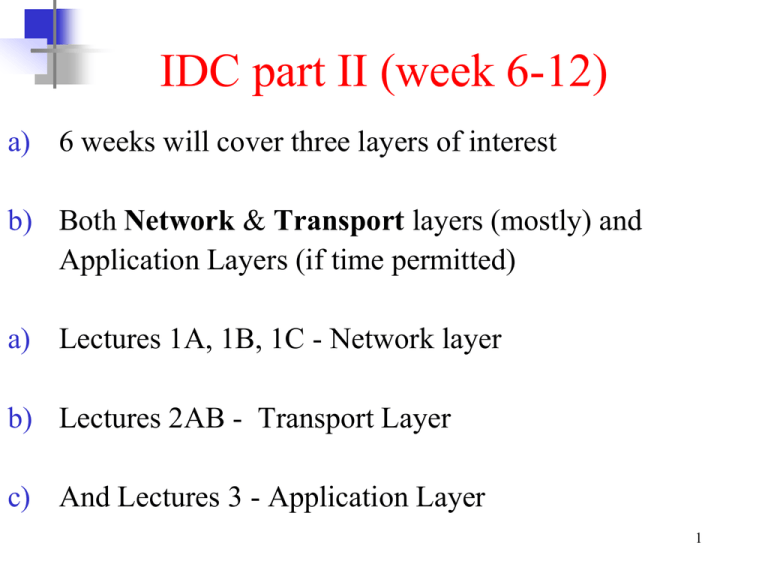
IDC part II (week 6-12) a) 6 weeks will cover three layers of interest b) Both Network & Transport layers (mostly) and Application Layers (if time permitted) a) Lectures 1A, 1B, 1C - Network layer b) Lectures 2AB - Transport Layer c) And Lectures 3 - Application Layer 1 Network Layer I (addressing) Introduction to Network Layer A network. Responsibilities and functionalities of the network layer. Virtual Circuit Switching and Datagram Routing. INTERNETWORKING Concept of IP Addressing CLASSFUL VS. CLASSLESS Network address Subnetting Supernetting Classless Addressing slash notation how to find network address and range of addresses in a block 2 A Sample Network fig 5-1 3 Layers a) In the sense of purpose and responsibility, each layer is separate and independent b) Each has its own function, but also provides a service to those layers above and below itself c) The OSI and TCP/IP models should be considered an aid to understanding the nature of communication on the network – and useful in sorting out troubles that might occur on a network d) By providing layer structure, it allows both software engineers and hardware manufacturers ensure their products work together. 4 Where is the network layer? a)There are 7 layers from OSI model and 5 layers from TCP/IP model (discuss later!) b)From OSI model, the Network layer rests between the upper layer called the Transport layer and the lower layer called the Data Link Layer. c)From the TCP/IP model, the Network layer is called the Internet layer and it rests between the upper Transport layer and the lower Host to Network layer. 5 Position of network layer 6 Network layer duties • The key is interconnecting different networks (various LAN technologies, telephone network, satellite link, ATM networks etc.) and making them look the same to the upper layer; i.e. logical gluing of heterogeneous physical networks together to look like a single network to the Transport & Application layer. • Additional notes: The transport layer should not be worried about the underlying physical network ! 7 Network layer duties • The addresses must be uniquely and universally define the connection of a (host/router/machine/device/user) to the internet. Two devices on the internet can never have the same address. (Address per connection) Remember, network layer is independent of the data link layer. We cannot use the data link layer addresses !! Because these addresses depend on the technology used in the data link layer. 8 Network layer duties • Network layer encapsulates packets received from upper layer protocols and makes new packets. (Re-packaging). • This is a task common to all layers. • In the Internet model, packetizing is done by network layer protocol called IP – Internetworking Protocol. • The Protocol Data Units (PDU’s) coming from the transport layer must be placed in network-layer packets and sent to the data-link layer. 9 Network layer duties • A packet can travel through different networks. Each router decapsulates the IP datagram from the received frame, processes it and then encapsulates it in another frame. The format & size depend on the physical network. • Remember, the network layer must be able to operate on top of any data-link layer technology (Ethernet, Fast Ethernet, ATM etc.). All these technologies can handle a different packet length. • The network layer must be able to fragment transport layer PDUs into smaller units so that they can be transferred over various data10 link layer technologies. Network layer duties • Now that you have your network layer packet, where do you send it ? Each packet reaches its destination via several routes. • So, which route is suitable or optimum? Issue of speed, reliability, security etc. (routing algorithm) • Packet cannot choose the route; the routers connecting the LANs/WANs makes this decision. • (refer Chap-19 of Forouzan’s book). 11 Internetworking How can data be exchanged between networks? They need to be connected via routers/links to make an internetwork. • The above internetwork is made of 5 networks: 4 LANs and 1 WAN. • E.g. If host A needs to send a data packet to host D, the packet needs to go from A to S1, then from S1 to S3, and finally from S3 to D. Therefore the packet passes through 3 links. 12 Internetworks link-1 link-2 link-3 • Problem: how does S1 know that they should send out from f3 after packet arrive at f1 from A? (No provision in data-link layer to help S1 making the decision and the frame only contains the MAC addresses-pair of 1st link) • To solve the problem of delivery thru several links, the network layer was designed and responsible for host-to-host delivery and for routing the packets thru different routers. 13 Switching Used in computer networks and (also in modern telephone networks). Packets of bits (not lines) are switched! A physical link is dedicated between Source and Destination. E.g. telephony system (Also called Connection-oriented networking) (Also called Connectionless networking) 14 Datagram approach 15 Virtual Circuit Approach 16 More on Virtual Circuits 17 Comparison of Virtual-Circuit and Datagram Approaches 5-4 18 Internet Protocol (IP) IP connectionless network-layer protocol. IP is based on datagram routing. IP is unreliable !! IP has a two-level (at least, traditionally) hierarchical addressing mechanism. Routing in IP is a mixture of hierarchical, distance vector and link state routing algorithms. 19 Concept of Addressing in Network Layer 20 Relationship of Binary & Dotted-decimal notation 21 Example Change the following IP address from binary notation to dotted-decimal notation. 10000001 00001011 00001011 11101111 Solution 129.11.11.239 22 Example Change the following IP address from dotted-decimal notation to binary notation. 111.56.45.78 Solution 01101111 00111000 00101101 01001110 23 IP-Addressing a) The identifier used in network layer to identify each device connected to the Internet is called the Internet address or IP address. b) In IPv4, an IP address is a 32-bit binary address (4-bytes) that uniquely and universally defines the connection of a host or a router to the Internet. (Universal in the sense that the addressing system must be accepted by any host that wants to be connected to Internet). c) Each IP address is unique and only defines 1 connection to the Internet. d) Two devices on the internet can never have the same address at the same time. (Need 2 separate IP addresses). e) Two types of IP addressing: Classful vs. Classless f) In classful address, there are Class A, B, C, D & E. 24 IP Addresses Unicast Multicast 25 Classful Addressing: Finding the class in binary notation 26 Classful Addressing: Finding the class in decimal notation 27 Subnetting in Classful Addresses Classful addressing in IP is both inflexible and inefficient ! 0.0.0.0 to 127.255.255.255 128.0.0.0 to 191.255.255.255 192.0.0.0 to 223.255.255.255 allows 127 networks and 16 777 214 hosts on each network 7 bits = 27 -1: exclude 0.0.0.0 24 bits = 224 -2: exclude 1st and last IP allows 16384 networks and 65534 hosts on each network 14 bits = 214 16 bits = 216 -2: exclude 1st and last IP allows 2 097 152 networks and 254 hosts on each network 21 bits = 221 8 bits = 28 -2: exclude 1st and last IP Note: In each network, the 1st IP address is the Network Address (e.g. 73.0.0.0) 28 and the last IP address is for special purpose (e.g. 73.255.255.255) . Finding the address class 29 Classful Addressing a) Unicast address: one source to one destination; Class A, B & C. b) Multicast address: one source to a group of destination: only as destination address not source address; Class-D. c) IP addresses in class A, B, C are divided into different length of: Network-ID (netid) and Host-ID (hostid) d) Concept of Classes and Blocks (networks): - for example: In class-A, 1st block covers from 0.0.0.0 to 0.255.255.255 (net-ID 0) 2nd block covers from 1.0.0.0 to 1.255.255.255 (net-ID 1) last block covers from 127.0.0.0 to 127.255.255.255 (net-ID 127) • Note that: block = class + netid + hostid • One problem with classful addressing is that each class is divided into a fixed number of blocks with fixed size. (read Forouzan’s text) • Plenty of IP addresses wasted!!! in classful addressing method. 30 128 Blocks in class A 1st IP used to identify organisation to the rest of Internet 3 bytes = 224 Last IP reserved for special purpose; not allowed to use 31 Millions of class A addresses are wasted. 16384 Blocks in class B 16 blocks for private addressees leaving 16368 blocks Class B for midsize organisation. 16384 organizations are class-B 32 Many of class B addresses are wasted. 2,097,152 Blocks in class C 256 blocks for private addressees leaving 2,096,896 blocks Class C for small organisation. Limited IP address in each blocks, which is smaller than the needs of most organisations 33 Class D addresses are used for multicasting; there is only one block in this class. Class E addresses are reserved for special purposes; most of the block is wasted. 34 Network Addresses The network address is the first address. The network address defines the network to the rest of the Internet. Given the network address, we can find the class of the address, the block, and the range of the addresses in the block 35 Figure 4-13 Network addresses In classful addressing, the network address (the first address in the block) is the one that is assigned to the organization. 36 Example Given the network address 17.0.0.0, find the class, the block, and the range of the addresses. Solution The class is A because the first byte is between 0 and 127. The block has a netid of 17. The addresses range from 17.0.0.0 to 17.255.255.255. 37 Example Given the network address 132.21.0.0, find the class, the block, and the range of the addresses. Solution The class is B because the first byte is between 128 and 191. The block has a netid of 132.21. The addresses range: 132.21.0.0 to 132.21.255.255. 38 Example Given the network address 220.34.76.0, find the class, the block, and the range of the addresses. Solution The class is C because the first byte is between 192 and 223. The block has a netid of 220.34.76. The addresses range from 220.34.76.0 to 220.34.76.255. 39 Sample Internet Note: When it comes to routing, the outside world recognises the network via network address, not the individual host-IPs 40 Network Addresses The network address is the beginning address of each block. It can be found by applying the default mask to any of the IP addresses in the block. It retains the netid of the block and sets the hostid to zero. We must not apply the default mask of one class to an address belonging to another class. 41 Concept of Masking A mask is a 32-bit binary number or 4-bytes that gives the first address in the block (the network address) when bitwise ANDed with an address in the block. 42 Default Mask Default class A mask is 255.0.0.0 Default class B mask is 255.255.0.0 Default class C mask is 255.255.255.0 43 Example Given the address 23.56.7.91 and the default class A mask, find the beginning address (network address). Solution The default mask is 255.0.0.0, which means that only the first byte is preserved and the other 3 bytes are set to 0s. The network address is 23.0.0.0. 44 Example Given the address 132.6.17.85 and the default class B mask, find network address. Solution The default mask is 255.255.0.0, which means that the first 2 bytes are preserved and the other 2 bytes are set to 0s. The network address is 132.6.0.0. 45 Example Given the address 201.180.56.5 and the class C default mask, find the network address. Solution The default mask is 255.255.255.0, which means that the first 3 bytes are preserved and the last byte is set to 0. The network address is 201.180.56.0. 46 IP-Addressing/Subnetting a) IP address designed with 2 levels of hierarchy: network-ID & host-ID. b) However, often organisation needs to assemble the hosts into groups: the network needs to be divided into several subnetworks (subnets); hence requires 3 levels of hierarchy. (netid: subnetid : hostid) c) Remember that, the outside world only knows the organisation by its network address. Inside the organisation each sub-network is recognised by its sub-network address. d) In subnetting, a network is divided into several smaller groups that have its own subnet address depends on the hierarchy of subnetting but still appear as a single network to the rest of the Internet. e) The question is how a router knows whether it is a network address or a subnet? The key is using the subnet mask. (similar to def. mask). f) Only the network administrator knows about the network address and subnet address but router does not. External router has routing table based on network addresses; Internal router has routing table based on 47 subnetwork addresses. A network with two levels of hierarchy (not subnetted) 48 Addresses in a network With and without subnetting Just like telephone system 49 Network Addresses/subnetting 2 Subnetworks Network Address 50 A network with three levels of hierarchy (subnetted) Internal routers External router 51 Default mask and subnet mask 52 Finding the Subnet Address Given an IP address, we can find the subnet address the same way we found the network address in the previous chapter. We apply the mask to the address. We can do this in two ways: straight or short-cut. 53 Straight Method In the straight method, we use binary notation for both the address and the mask and then apply the AND operation to find the subnet address. Short-Cut Method ** If the byte in the mask is 255, copy the byte in the address. ** If the byte in the mask is 0, replace the byte in the address with 0. ** If the byte in the mask is neither 255 nor 0, we write the mask and the address in binary and apply the AND operation. 54 Example What is the subnetwork address if the destination address is 200.45.34.56 given that the subnet mask is 255.255.240.0? Solution 11001000 00101101 00100010 00111000 11111111 11111111 11110000 00000000 11001000 00101101 00100000 00000000 The subnetwork address is 200.45.32.0. 55 Example What is the subnetwork address if the destination address is 19.30.84.5 and the mask is 255.255.192.0? Solution Answer: Subnet Address = 19.30.64.0 56 Comparison of a default mask and a subnet mask The number of subnets must be a power of 2. 57 Example A company is granted the site address 201.70.64.0 (class C). The company needs six subnets. Design the subnets. Solution The number of 1s in the default mask is 24 (class C). The company needs six subnets. Since 6 is not a power of 2, the next number that is a power of 2 is 8 (23). That means up to 8 subnets. Hence, we need 3 more ‘1’s in the subnet mask 11111111.11111111.11111111.11100000 or 255.255.255.224 The total number of 1s in the subnet mask is 27 (24 + 3). Since the total number of 0s is 5 (32 - 27). The number of addresses in each subnet is 25 (5 is the number of 0s) or 32. 58 = Solution (Continued) 59 Example A company is granted the site address 181.56.0.0 (class B). The company needs 1000 subnets. Design the subnets. Solution The number of 1s in the default mask is 16 (class B). The company needs 1000 subnets. Since it is not a power of 2, the next number is 1024 (210). We need 10 more 1s in the subnet mask. The total number of 1s in the subnet mask is 26 (16 + 10). The total number of 0s is 6 (32 - 26). 60 Solution (Continued) The submask is 11111111 11111111 11111111 11000000 or 255.255.255.192. The number of subnets is 1024. The number of addresses in each subnet is 26 (6 is the number of 0s) or 64. 61 Solution (Continued) 62 Subnetting in Classful Addresses Class B addess Network Prefix Subnet ID Subnetting with /20 mask 10000000 00010100 00000000 00000000 Network Prefix Host Suffix Host ID 63 Subnetting in Classful Addresses 64 Supernetting a) Although class A and B addresses are almost depleted, Class C addresses are still available. b) However, the size of a class C block with a maximum number of 256 addresses may not satisfy the needs of an organisation. c) One solution is supernetting. d) In supernetting, an organisation can combine several class C blocks to create a large range of addresses. e) In order words, several networks are combined to create a supernetwork. This is done by applying a set of class C blocks instead of just one. 65 Example of a Supernetwork 66 Rules: The number of blocks must be a power of 2 i.e: (2, 4, 8, 16, . . .). The blocks must be contiguous in the address space (no gaps between the blocks). The third (3rd) byte of the first (1st) address in the superblock must be evenly divisible by the number of blocks. In other words, if the number of blocks is N, the third byte must be divisible by N. 67 Example A company needs 600 addresses. Which of the following set of class C blocks can be used to form a supernet for this company? a. 198.47.32.0 198.47.33.0 198.47.34.0 b. 198.47.32.0 198.47.42.0 198.47.52.0 198.47.62.0 c. 198.47.31.0 198.47.32.0 198.47.33.0 198.47.52.0 d. 198.47.32.0 198.47.33.0 198.47.34.0 198.47.35.0 Solution a: No, there are only three blocks. (not to the power of 2) b: No, the blocks are not contiguous. c: No, 31 in the first block is not divisible by 4. d: Yes, all three requirements are fulfilled. 68 Vital notes: Supernetting In subnetting, we need the first address of the subnet and the subnet mask to define the range of addresses. In supernetting, we need the first address of the supernet and the supernet mask to define the range of addresses. 69 Comparison of subnet, default, and supernet masks 70 Example We need to make a supernetwork out of 16 class C blocks. What is the supernet mask? Solution Class C mask is defaulted with 24 of ‘1’ is 11111111 11111111 11111111 00000000 We need 16 blocks. For 16 blocks we need to change four 1s to 0s in the default mask. So the mask is 11111111 11111111 11110000 00000000 or 255.255.240.0 71 Example A supernet has a first address of 205.16.32.0 and a supernet mask of 255.255.248.0. A router receives 3 packets with the following destination addresses: 205.16.37.44 Q: Which packet belongs to the supernet? 205.16.42.56 205.17.33.76 Solution We apply the supernet mask to find the beginning address. 205.16.37.44 AND 255.255.248.0 205.16.32.0 205.16.42.56 AND 255.255.248.0 205.16.40.0 205.17.33.76 AND 255.255.248.0 205.17.32.0 Only the first address belongs to this supernet. 72 Example A supernet has a first address of 205.16.32.0 and a supernet mask of 255.255.248.0. How many blocks are in this supernet and what is the range of addresses? Solution The supernet mask has 21 ‘1’s. The default mask has 24 1s. Since the difference is 3, there are 23 or 8 blocks in this supernet. The blocks are 205.16.32.0 to 205.16.39.0. The first address is 205.16.32.0. The last address is 205.16.39.255. 73 Classless Addressing a) The idea of Classful addressing has created many problems. b) Until mid-1990s, a range of addresses meant a block of addresses in class A, B or C. c) The minimum number of addresses granted to an organisation as 256 (class C); the maximum as 16,777,216 (class A). d) In between these limits, an organisation could have a class B block or several class C blocks. However, the choices were limited. e) In addition, what about the small business that needed only 16 addresses? Or a household that needed only 2 addresses? f) Solution: Classless addressing (from 1996) g) The idea is to have variable-length blocks that belongs to no class. 74 Classless Addressing Rules: Number of Addresses in a Block There is only one condition on the number of addresses in a block; it must be a power of 2 (2, 4, 8, . . .). For exmaple, a household may be given a block of 2 addresses. A small business may be given 16 addresses. A large organization may be given 1024 addresses. 75 Classless Addressing Rules: Beginning Address The beginning address must be evenly divisible by the number of addresses. For example, if a block contains 4 addresses, the beginning address must be divisible by 4. If the block has less than 256 addresses, we need to check only the rightmost byte. If it has less than 65,536 addresses, we need to check only the two rightmost bytes, and so on. 76 Example Which of the following can be the beginning address of a block that contains 16 addresses? 205.16.37.32 190.16.42.44 17.17.33.80 123.45.24.52 Solution The address 205.16.37.32 is eligible because .32 is divisible by 16. The address 17.17.33.80 is eligible because 80 is divisible by 16. 77 Example Which of the following can be the beginning address of a block that contains 1024 addresses? 205.16.37.32 190.16.42.0 17.17.32.0 123.45.24.52 Solution To be divisible by 1024, the rightmost byte of an address should be 0 and the second rightmost byte must be divisible by 4. Only the address 17.17.32.0 78 meets this condition. Slash notation To enable the variable-length blocks, the slash notation is introduced Slash notation is also called CIDR notation/prefix length represented using ‘1’, as masking. CIDR = Classless InterDomain Routing The remaining unmasked ‘0’ is referred to the suffix length Subnetting with /20 mask = 128.20.0.0/20 Network Prefix Subnet ID Class B address 10000000 00010100 00000000 00000000 Host Suffix Network Prefix Host ID 79 CIDR Addressing in Internet Protocol CIDR allows each IP address to have a different length of network ID and host ID. In CIDR each IP address is assigned a 32-bit mask to extract the network ID. 128.192.111.202 / 29 10000000 11000000 01101111 11001010 11111111 11111111 11111111 11111000 10000000 11000000 01101111 11001000 Counts the number of ‘1’ in this case 29 from the leftmost Network ID: 128.192.111.200 The prefix length is 29 and suffix length is 3 80 CIDR Addressing in Internet Protocol 153.237.108.227 /19 Counts the number of ‘1’ – in this case 19 from the left 10011001 11101101 01101100 11100011 11111111 11111111 11100000 00000000 10011001 11101101 01100000 00000000 Network ID: 153.237.96. 0 The prefix length is 19 and suffix length is 13 81 Classless InterDomain Routing (CIDR) Addressing in Internet Protocol 128.192.111.192 /29 128.192.111.194 /29 128.192.111.194 /29 2 Subnetworks 128.192.111.200 /29 128.192.111.201 /29 128.192.111.202 /29 128.192.111.192 /28 10000000 11000000 01101111 1100000 82 A block in classes A, B, and C can easily be represented in slash notation as: A.B.C.D/ n where n is either 8 (class A), 16 (class B), or 24 (class C). 83 Example A small organization is given a block with the beginning address and the prefix length 205.16.37.24/29 (in slash notation). What is the range of addresses in the block? Solution The beginning address is 205.16.37.24. To find the last address we keep the first 29 bits and change the last 3 bits to 1s. Beginning:11001111 00010000 00100101 00011000 Ending : 11001111 00010000 00100101 00011111 There are only 8 addresses in this block. Alternatively, we can argue that the length of the suffix is 32 - 29 or 3. So there are 23 = 8 addresses in this block. If the first address is 205.16.37.24, the last address is 205.16.37.31 (24 + 7 = 31). 84 Example What is the network address if one of the addresses is 167.199.170.82/27? Solution The prefix length is 27, which means that we must keep the first 27 bits as it is and change the remaining bits (5) to 0s. The 5 bits affect only the last byte. The last byte is 01010010. Changing the last 5 bits to 0s, we get 01000000 or 64. The network address is 167.199.170.64/27. 85 Example An organization is granted the network address block of 130.34.12.64/26. The organization needs to have four subnets. What are the subnet addresses and their range for each subnet? Solution The suffix length is 6 (32-26). This means the total number of addresses in the block is 64 (26). If we create four subnets, each subnet will have 16 addresses. Let us first find the subnet prefix (subnet mask). We need four subnets, which means we need to add two more ‘1’s to the site prefix /26. The subnet prefix is then /28. Subnet 1: 130.34.12.64/28 to 130.34.12.79/28. Subnet 2 : 130.34.12.80/28 to 130.34.12.95/28. Subnet 3: 130.34.12.96/28 to 130.34.12.111/28. Subnet 4: 130.34.12.112/28 to 130.34.12.127/28. 86 Example 87 Example An ISP is granted a block of addresses starting with 190.100.0.0/16. The ISP needs to distribute these addresses to three groups of customers as follows: 1. The first group has 64 customers; each needs 256 addresses. 2. The second group has 128 customers; each needs 128 addresses. 3. The third group has 128 customers; each needs 64 addresses. Design the subblocks and give the slash notation for each subblock. Find out how many addresses are still available after these allocations. 88 Solution Group 1 For this group of 64 customers, each customer needs 256 addresses. This means the suffix length is 8 (28 = 256). The prefix length is then 32 - 8 = 24. 01: 190.100.0.0/24 190.100.0.255/24 02: 190.100.1.0/24 190.100.1.255/24 ………………………………….. 64: 190.100.63.0/24190.100.63.255/24 Total = 64 256 = 16,384 89 Solution (Continued) Group 2 For this group of 128 customers, each customer needs 128 addresses. This means the suffix length is 7 (27 = 128). The prefix length is then 32 - 7 = 25. The addresses are: 001: 190.100.64.0/25 190.100.64.127/25 002: 190.100.64.128/25 190.100.64.255/25 ………………………………….. 127: 190.100.127.0/25 190.100.127.127/25 128: 190.100.127.128/25 190.100.127.255/25 Total = 128 128 = 16,384 90 Solution (Continued) Group 3 For this group of 128 customers, each customer needs 64 addresses. This means the suffix length is 6 (26 = 64). The prefix length is then 32 - 6 = 26. 001:190.100.128.0/26 190.100.128.63/26 002:190.100.128.64/26 190.100.128.127/26 ………………………… 128:190.100.159.192/26 190.100.159.255/26 Total = 128 64 = 8,192 91 Solution (Continued) Number of granted addresses: 65,536 Number of allocated addresses: 40,960 Number of available addresses: 24,576 The available addresses range from: 190.100.160.0 190.100.255.255 Total = 96 256 = 24,576 92 Further Reading 1- Chp-5 from “Computer Networks”, Andrew Tanenbaum, 4th Ed. to learn more about the generic network layer. 2- “Internetworking with TCP/IP vol.1”, Douglas Comer, 4th Ed., provides a detailed and comprehensive presentation of TCP/IP. 3- “Data Communications and Networking”, Behrouz Forouzan, 4th Ed., when you get confused and wonder if there’s a simpler explanation of all these issues. Copyright Information : Some figures used in this presentation have been either directly copied or adapted from several books. 93
